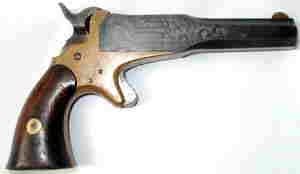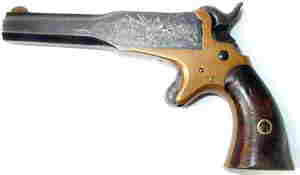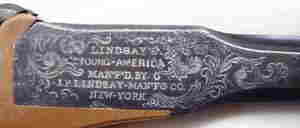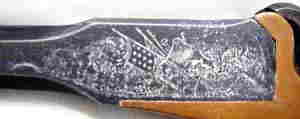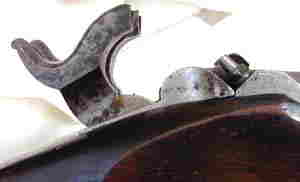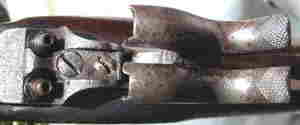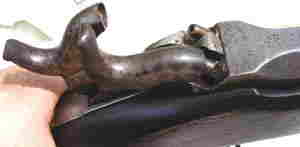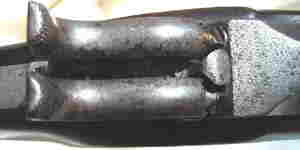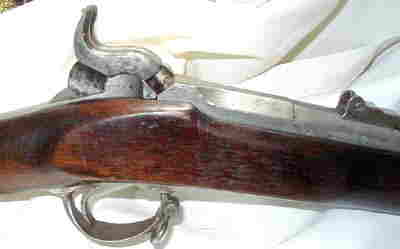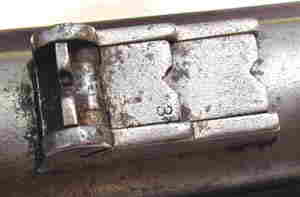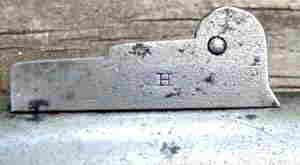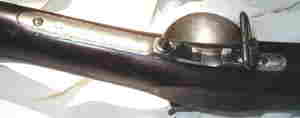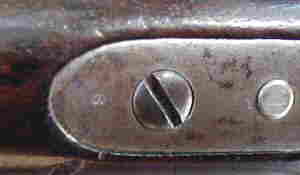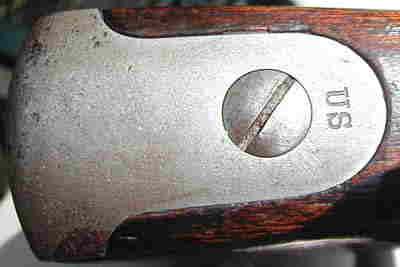|
Double
Or Nothing!! |
|
|
Inventor J. P. Lindsay had a thing for guns with superposed loads, two hammers, a single trigger and a single barrel. The story goes that J.P.'s brother had a run in with two Indians and he was armed only with a standard single shot musket. Being a expert shot, he brought down one of the two Indians charging him. Trying to reload, while looking back and forth at his gun and at the Indian still charging him, and possibly still admiring his marksmanship, he was unable to bring his musket up in time to stop the second assailant. He died in the effort. |
|
|
J.P. felt that if his brother had the time to get two shots off, he would not have been killed (and scalped) by the second attacker. Armed with that thought he produced 3 distinctive two shot, single barrel handguns and the Model 1863 U.S. Double Rifle Musket. |
|
|
All 3 of his pistols were made by the Union Knife Company, Naugatuck, Connecticut for the inventor. The first pistol with a 4½' to 5½" barrel was a "belt pistol" made in the early 1860s. The second gun with a 4" barrel, referred to as a "pocket pistol", was also made in the early 1860s. Both guns were .41 cal. The third weapon, a martial size pistol with a 8½" barrel of .45 cal. was manufactured in the same time period. About 100 each of the belt and martial size pistols were made compared with several hundred of the pocket model pictured herein. About 1,000 of the Lindsay rifled musket, also featured below, were manufactured in 1863-64. |
|
|
All these guns are oddities in the arms collecting field. They are quite interesting but dangerous in some ways. The hammers can be cocked individually or together. If both hammers are cocked, the right hammer always falls first. It's firing channel ignites the forward or second (front) load which is superposed over the first load. The minie ball of the first load serves as a check against ignition of the powder behind it when the second load is set off by the flame from the percussion cap. Pulling the trigger again drops the left hammer which ignites the back or first load. This is all well and good, but there are several things that could and probably did go wrong. |
|
|
If one would put too much powder in the first load, the projectile, either ball or minie, sitting on top of the excess powder would block the firing channel of the forward or second load causing a misfire. If one cocked only the left hammer and pulled the trigger with both loads being in the weapon, the back projectile would push the forward load, powder ball and all, out the front of the barrel (hopefully). If not, something else, such as the barrel itself, would explode. It is doubtful that both powder loads would ignite simultaneously as the rear ball would also block ignition of the powder in front of it. But what if one or both of the lead balls were a little undersized or deformed? Then it wouldn't matter what hammer dropped first. |
|
|
Also, when using the musket in battle with both hammers cocked and percussion caps in place, it would be possible to lose the right cap. In the terrible noise and mental confusion of battle, it's difficult to hear your own gun firing with others firing closely to your left, right, center and rear. You pull the trigger once - the hammer finds no cap. You pull the trigger again, a cap is struck and the fun begins (or ends). Of course, the safest thing to do would be to cock only one hammer at a time. If only one is cocked that one will drop at the pull of the trigger, whether it's the right or left hammer. But one has to remember to cock and fire the right hammer first. I hope everyone read the instructions carefully before using these guns. If you didn't know your right from your left, it was trouble all the way! |
|
|
The Model 1863 U.S. Double Rifle was accepted on August 12, 1864 and used in combat at Peebles Farm, Virginia by members of the 16th Michigan Volunteer Infantry. Reports indicate that both charges often ignited simultaneously destroying the barrel(s). The involved loading and firing system, along with lack of acceptance from the units they were issued to, lead to a relatively short issuance life. |
|
|
I wonder, and so must have J.P. Lindsay, if this contraption really would have saved his brother's life after all. However, it might well have saved the life of that first Indian, if his brother had cocked the wrong hammer or overloaded it! |
|
|
Please note that the described adverse happenings are based on my opinion from playing with these guns and that the information regarding his brother has been called up from memory. I can't remember where I read it or if someone told me that story. But it does make for an interesting story, doesn't it? |
|
|
Enough of the story, here are the pictures and statistics:
|
|
|
|
|
|
J.
P. Lindsay's |
|
|
Right Side View |
Left Side View |
|
Right Breech Flat Engraving |
Left Breech Flat Engraving |
|
Top View with Hammers Cocked |
|
|
Serial
Number and Patent Stampings |
|
|
The measurements of this little pistol are 6½" overall with the .41 caliber octagon barrel from the breech to the tip of the muzzle measuring 4". The loading chambers appear to be 1½". The barrel is fluted at the top. The markings on the right side of the barrel, at the breech, are LINDSAY'S/YOUNG-AMERICA / MAN'F'D BY / J.P. LINDSAY-MAN'FG CO. / NEW YORK" in four lines within a scroll engraved panel that extends forward on the barrel. The left panel is profusely engraved, left to right, with a laying down male lion, flags, military trophies and an eagle. On the bottom of the blued barrel, at the frame, is the serial number, "954". Running length-wise in two lines is "PATENT'D. FEB. 8 1859" over "PATENT'D. OCT. 9. 1860" The frame is brass. The hammers and two stage spur trigger are blued steel. The grips are walnut. |
|
|
|
|
|
J.
P. Lindsay's |
|
|
Right Side View |
|
|
Hammers Cocked - Side View |
Hammers Cocked - Top View |
|
Right Hammer Down-Left Hammer Up |
Hammers Down - Top View |
|
Side View of Breech Section |
|
|
Top View of Rear Sight |
Side View
of Sight |
|
Bottom Trigger Guard View |
"S" Sub Inspector Mark |
|
Top View - Butt |
|
|
Left Side View |
|
|
This gun is 56" overall with a 41-1/8" round barrel and semi-octagonal breech. There are two nipples, two hammers and a single two stage trigger. There are three barrel bands. It has a tulip head swelled ramrod. All metal parts are finished bright. The front sight doubles as a lug for a triangular socket bayonet. The stock is walnut. |
|
| Although only faintly visible on the pictured weapon, the barrel is marked on the top of the breech, "LINDSAY / PATENT'D. OCT. 9. 1860." in two lines. There is a "U.S." on the butt plate tang. A sub inspector mark, "H" is on the right side of the sight and there is an "S" at the rear of the trigger guard. The inspector's initials of "ADK" and those of a sub inspector were stamped on the left flat of the stock near the breech. These marks are only imaginable on the pictured musket. | |
| Once again reference credits should be given to Flayderman's Guide to Antique Firearms by Norm Flayderman and U.S. Military Small Arms 1816-1865 by Robert M. Reilly. The webmaster for this page is my son, Reed R. Radcliffe. He should also receive the credit he so richly deserves. | |
|
|
|
|
Dave Radcliffe
|
|
